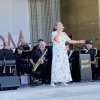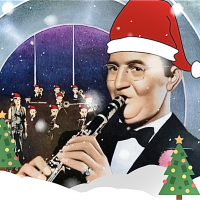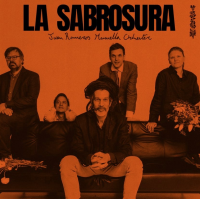Home » Jazz Musicians » Artie Shaw
Artie Shaw

Artie Shaw, a brilliant jazz clarinetist, was one of the most enigmatic, daring and adventurous bandleaders of the swing-era. An intellectual, he hated public life and the music industry. Over the course of his short career he formed ten orchestras and disbanding most of them after only a few months. At the peak of his career in the years just before World War II, Shaw was matched by few other musicians in popularity and technical skill.
Born Arthur Arshawsky in New York City and raised in Connecticut, Shaw took up the saxophone at an early age and began playing professionally when he was only 14. He left home at 15 for a job in Kentucky. The position never materialized and he was forced to play with traveling orchestras in order to get home. At age 16 he switched to the clarinet and went to Cleveland, where he spent three years playing in local groups, including that of Austin Wylie.
In 1929 Shaw joined Irving Aaronson's Commanders. While traveling the country with the band he discovered the works of contemporary avant-garde classical composers whose influence would later surface in his own music. When the Commanders arrived for a gig in New York, Shaw decided to remain. There he freelanced with many of the top artists of the day, including Vincent Lopez, Red Nichols, and Teddy Wilson. He also briefly spent time with Fred Rich's orchestra and toured with Roger Wolfe Kahn.
In 1934 Shaw became disillusioned with the music industry and quit for the first of what would be many times. He bought a farm in Pennsylvania and tried his hand at being a writer. He soon returned to New York and took up studio work again. He was one of the most successful studio musicians in the city when in 1935 he was asked to lead a small group during intermissions at a swing concert held by the Imperial Theater. He put together an unusual outfit consisting of a string quartet, a rhythm section minus piano, and his clarinet.
Shaw's unique combination was wildly received by the audience. He was offered financial backing to form his own orchestra, and in 1936 he debut his first dance band, which featured a Dixieland approach and a string quartet. The new group made some impressive recordings but couldn't compete with the brassier swing orchestras of the day, so Shaw disbanded it the following year and formed a more conventional big band.
Read moreTags
The Cinderella So Few Got to Hear: Late Artie Shaw is the Best Artie Shaw

by Richard J Salvucci
Artie Shaw will always be a bit of a puzzle to his fans--"morons, “ as he once characterized some of us. The best band he ever fronted, and said so more than once, was his 1949-50 “bop" band. Benny Goodman had a similar outfit around the same time, which, like Shaw's, featured excellent young musicians who were comfortable with the bop idiom. But as for the clarinet playing, Goodman's remained more swing than bop, while Shaw's was arguably the other ...
Continue ReadingThe Swing Era Big Bands (1936 - 1941)

by Russell Perry
In the late 1930s and early 1940s, the very dance-oriented swinging music of the Big Bands was the most popular music around. Never had jazz been more central to mass culture. Just over the horizon were the draft of 1940 that eventually conscripted 10 million men, making it increasingly difficult to field top notch bands; war shortages of gasoline and shellac limiting both touring and recording; the economic infeasibility of touring with 16-member orchestras; the musicians strike and recording ban ...
Continue Reading100 Years of Artie Shaw

by George Kanzler
Artie ShawThe Last Recordings Vol. 1MusicMaster-Nimbus2009 Artie ShawThe Last Recordings Vol. 2MusicMaster-Nimbus2009 Artie ShawThe Last Recordings Vol. 3MusicMaster-Nimbus2009 Artie ShawThe Complete Spotlight Band 1945 BroadcastsHep Jazz2009 Artie ShawComplete Thesaurus Transcriptions 1949Hep Jazz2010
Continue ReadingArtie Shaw: Classic Bluebird and Victor Sessions

by Samuel Chell
Artie ShawClassic Bluebird and Victor SessionsMosaic Records2009Shortly after its critically acclaimed box set comprising clarinetist Benny Goodman's essential recordings-- The Columbia and Okeh Benny Goodman Orchestra Sessions (2009), which was released to coincide with the centenary of the “King of Swing"--Mosaic Records has done it again. The Classic Artie Shaw Bluebird and Victor Sessions arrives in time for the 100th birthday (May 23, 2010) of the clarinetist who was the instrumental bobby-soxer ...
Continue ReadingObituary: Artie Shaw

by AAJ Staff
Artie Shaw died December 30th at the age of 94. It seems almost befitting that Shaw, the musician that despised fame, would pass on after all the magazines and newspapers went to press with their year-end tributes to the entertainers who died in 2004. “The public and I have nothing to do with each other," Shaw said in a 2002 interview. “I have succeeded in spite of the public." Well, the public may not have always accepted Shaw's music, but ...
Continue ReadingArtie Shaw: "Begin the Beguine"

by David Rickert
Dueling Clarinetists
During the Swing Era Benny Goodman and Artie Shaw were the clarinetists that reigned supreme and serious fans divided themselves into factions that loved one or the other. Goodman was the peddler of popular tunes who got the crowd on their feet, while Shaw was the musician's musician who preferred to make artistic statement that people listened to.
While both left their mark on the time period, nobody felt the tension between art and entertainment like ...
Continue ReadingArtie Shaw: Clarinetist and Bandleader, 1910-2004

by Mark Sabbatini
“His use of strings and arrangements blending commercialism with interesting musical values was almost unique of its kind. But Shaw was a contrary soul, critical of any pandering to audiences." - “The Penguin Guide To Jazz On CD," referring to Artie Shaw
For someone hoping to pitch swing-era big band music to today's counterculture, Artie Shaw might be the perfect choice.
The famous clarinetist died Dec. 29, 2003, at the age of 94 from ...
Continue ReadingOn April 25, Explore The Life And Times Of A Singular Jazz Icon With 'Artie Shaw: Time Is All You've Got', Winner Of The 1986 Oscar For Best Documentary, Now Restored In 4k

Source:
Michael Krause
Outspoken, manipulative, independent thinking and oftentimes controversial, Artie Shaw (1910-2004) was one of the most popular stars of the Swing Era, who famously broke the color barrier by hiring the legendary Billie Holiday, Hot Lips Page and Roy Eldridge for his bands. His complex love-hate relationship with his own celebrity caused him to walk away from performing almost as many times as he walked away from his marriages. Winner of the 1986 Academy Award for Best Documentary Feature, Artie Shaw: ...
read more
Interview: Artie Shaw Takes the Gloves Off

Source:
JazzWax by Marc Myers
I've long known that Artie Shaw was outspoken, mercurial and blunt. As a boy wonder in the band business in the 1930s, Shaw was also temperamental and didn't tolerate boredom or repetition for long. But I didn't realize how outspoken he was until I heard a lengthy interview with Shaw that surfaced last week. Pete Neighbour, a clarinetist and saxophonist, alerted me to it. Interviewed by Joe Smith of the Library of Congress on July 1, 1986, Shaw spoke freely. ...
read more
Jazz Musician of the Day: Artie Shaw

Source:
Michael Ricci
All About Jazz is celebrating Artie Shaw's birthday today!
Artie Shaw, a brilliant jazz clarinetist, was one of the most enigmatic, daring and adventurous bandleaders of the swing-era. An intellectual, he hated public life and the music industry. Over the course of his short career he formed ten orchestras and disbanding most of them after only a few months. At the peak of his career in the years just before World War II, Shaw was matched by few other musicians ...
read more
Jazz Musician of the Day: Artie Shaw

Source:
Michael Ricci
All About Jazz is celebrating Artie Shaw's birthday today!
Artie Shaw, a brilliant jazz clarinetist, was one of the most enigmatic, daring and adventurous bandleaders of the swing-era. An intellectual, he hated public life and the music industry. Over the course of his short career he formed ten orchestras and disbanding most of them after only a few months. At the peak of his career in the years just before World War II, Shaw was matched by few other musicians ...
read more
Jazz Musician of the Day: Artie Shaw

Source:
Michael Ricci
All About Jazz is celebrating Artie Shaw's birthday today!
Artie Shaw, a brilliant jazz clarinetist, was one of the most enigmatic, daring and adventurous bandleaders of the swing-era. An intellectual, he hated public life and the music industry. Over the course of his short career he formed ten orchestras and disbanding most of them after only a few months. At the peak of his career in the years just before World War II, Shaw was matched by few other musicians ...
read more
Jazz Musician of the Day: Artie Shaw

Source:
Michael Ricci
All About Jazz is celebrating Artie Shaw's birthday today!
Artie Shaw, a brilliant jazz clarinetist, was one of the most enigmatic, daring and adventurous bandleaders of the swing-era. An intellectual, he hated public life and the music industry. Over the course of his short career he formed ten orchestras and disbanding most of them after only a few months. At the peak of his career in the years just before World War II, Shaw was matched by few other musicians ...
read more
Artie Shaw: Love of My Life

Source:
JazzWax by Marc Myers
Artie Shaw's first feature-length film was Second Chorus, in 1940. By then, the 30-year-old clarinetist was earning up to $60,000 a week ($1.1 million in today's dollars), becoming the best-paid and most celebrated music star of the swing era. That same year, he recorded his massive hit Frenesi with a pickup orchestra, married actress Lana Turner and appeared on the radio regularly behind George Burns and Gracie Allen (they each made $5,000 a week). Shaw formed a new band in ...
read more
Jazz Musician of the Day: Artie Shaw

Source:
Michael Ricci
All About Jazz is celebrating Artie Shaw's birthday today!
Artie Shaw, a brilliant jazz clarinetist, was one of the most enigmatic, daring and adventurous bandleaders of the swing-era. An intellectual, he hated public life and the music industry. Over the course of his short career he formed ten orchestras and disbanding most of them after only a few months. At the peak of his career in the years just before World War II... Read more.
Place our Musician of the ...
read more
Jazz Musician of the Day: Artie Shaw

Source:
Michael Ricci
All About Jazz is celebrating Artie Shaw's birthday today!
Artie Shaw, a brilliant jazz clarinetist, was one of the most enigmatic, daring and adventurous bandleaders of the swing-era. An intellectual, he hated public life and the music industry. Over the course of his short career he formed ten orchestras and disbanding most of them after only a few months. At the peak of his career in the years just before World War II... Read more.
Place our Musician of the ...
read more
Jazz Musician of the Day: Artie Shaw

Source:
Michael Ricci
All About Jazz is celebrating Artie Shaw's birthday today!
Artie Shaw, a brilliant jazz clarinetist, was one of the most enigmatic, daring and adventurous bandleaders of the swing-era. An intellectual, he hated public life and the music industry. Over the course of his short career he formed ten orchestras and disbanding most of them after only a few months. At the peak of his career in the years just before World War II... Read more.
Place our Musician of the ...
read more









































